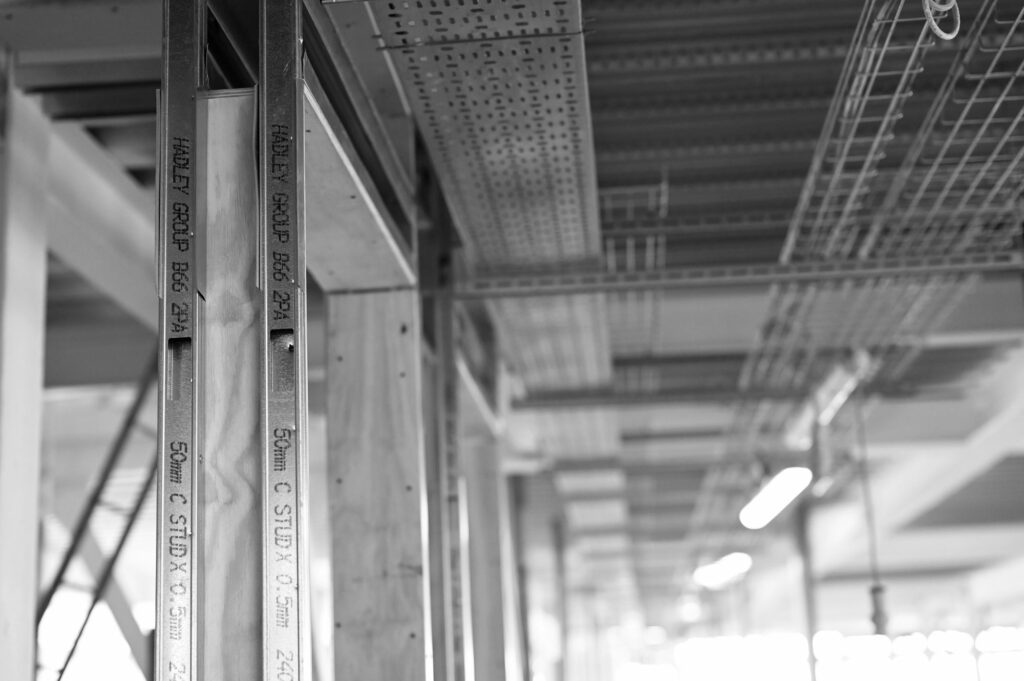Jump to our Drylining Systems and download Standard Details.
What is drylining?
Drylining systems—commonly referred to as drywall or plasterboard systems—are a popular and efficient method for constructing internal walls, ceilings, and partitions within buildings. These surfaces are visible from inside a building and are essential for ensuring the safety and security of both occupants and the general public. They serve as the primary means of passive fire protection, acoustic separation, and thermal resistance. These systems are commonly used in both residential and commercial properties because they are versatile, cost-effective, and easy to install.
Typically, drylining systems consist of the following components:
Insulation: Insulation can be made from stone or glass mineral wool, or various types of chemically manufactured insulation boards. Its purpose is to enhance fire safety, acoustic performance, and thermal efficiency.
Plasterboard: This is made with a gypsum-based core that includes various additives based on performance requirements, all sandwiched between two layers of heavy paper.
Framing: The framing is usually metal but can also be timber. It may be classified as either non-loadbearing or loadbearing, depending on the structure of the building.
Fixings: These are specified to mechanically secure the plasterboard to the framing system.
Jointing Materials: This includes a jointing slurry, which can be either powdered or ready-mixed, and may air-dry or chemically set. Additionally, jointing tape is used, which can be scrim (fiber), self-adhesive, or paper. Jointing materials help create a seamless finish between the plasterboards.
Plaster: Generally gypsum-based, but in some cases, it can be marble-based. Plaster can be supplied in powdered or ready-mixed forms and should always air-dry. Drylining is typically specified to be finished either Tape and Jointed (T&J) or plastered.
Mastic: Mastic is used to ensure that drylining is correctly sealed to adjoining materials. This helps meet fire safety, acoustic, smoke, and air permeability requirements.
Drylining systemization is crucial for building performance and comes in various systems to create a safe and functional environment.
- Single Stud Partitions: HadleySOLO systems can be non-load-bearing, featuring a single central stud that is clad on both sides with plasterboard.
- Twin Stud Partitions: HadleyDUO or HadleyBrace systems are non-load-bearing, consisting of two sets of studs with a central cavity that are clad on both sides with plasterboard.
- Resilient Bar Partitions: HadleyHUSH systems can be non-load-bearing. They include a single central stud to which HadleyResBar is applied on one or both sides, with plasterboard cladding on both sides.
- Staggered Stud Partitions: HadleyStagger systems are non-load-bearing and consist of two sets of studs positioned within a wider track, staggered left and right, and clad on both sides with plasterboard.
- Shaft Wall Partitions: HadleySHAFT systems are non-load-bearing and feature a single central stud clad on one side with plasterboard. Plasterboard is also fitted between the studs on the opposite side.
- Linings: HadleyLINE or HadleyShield systems are non-load-bearing, with either an unbraced single stud clad on one side with plasterboard, or a braced liner stud that is clad on one side with plasterboard.
- Ceilings: HadleyMF systems, which are non-load bearing but may help support load-bearing structures for fire safety. This system is suspended from a structure to create a grid that is clad in plasterboard on the underside.
- External walls can be constructed using HadleySFS systems, which may be loadbearing or non-loadbearing. These systems consist of a single central stud, to which plasterboard is attached on the interior face, while a sheathing board and other facade system components are applied externally.
Maintenance
Maintenance for HadleyDRYLINING partitions and systems is essential for ensuring their longevity, safety, and functionality. These partitions are often used in commercial, industrial, and residential buildings due to their durability and flexibility.
Our HadleySPEC Performance Warranty does not cover any form of damage or defect to our systems. Please check our Warranty for all exclusion information.
Below is a general maintenance guide for our HadleyDRYLINING partitions and systems:
Inspections:
– Surface Condition
Look for any Indents, scratches or Impact damage, moisture damage or stains.
– Alignment
Does the Partition look square and properly aligned?
– Gaps
Check for any widening gaps between the partition at edges and at any abutments
– Fire performance checks
Ensure that partitions are intact and no damage has occurred (for example: no damage to plasterboard, no holes within the partition system.no visual damage to fire resistant materials)
– Water Damage
Inspect for any signs of water ingress especially at the base of the system and around any penetrations.Cleaning:
– Surfaces
Use a dry soft cloth to wipe down metal surfaces to remove any dust and debris preventing build-up that could lead to rust or overall deterioration.
– Joints
Dust the joints between the plasterboard to ensure there is no mould or mildrew that could affect the systems performance.
– Metal
Metal Partitions and systems should be free from rust or any type of corrosion. If rust is detected please contact Hadley Technical Support for guidance.
By regularly maintaining metal drylining partitions and systems, you can ensure they continue to serve their purpose effectively and safely over time.
If any damage has occurred to the system and you wish to seek guidance from Hadley please contact our Technical Support Team who will be able to provide you with project specific guidance.
Download our Drylining partition recycling guide
You can rely on the Drylining Technical Team to provide drylining specification and detailed system data with technical drawings tailored to your project needs.
With years of experience, our Technical Team will work closely with you to provide advice through our support hotline, open 8:30-17:00 Monday to Friday (exc. Bank holidays).

System selection
You can review our range of drylining systems before discussing your project with our inhouse experts to have a tailored solution that meets your projects requirements, fully specified and tested.